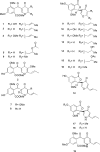Occurence and bioactivities of funicone-related compounds
- PMID: 19468317
- PMCID: PMC2680625
- DOI: 10.3390/ijms10041430
Occurence and bioactivities of funicone-related compounds
Abstract
Studies on production of secondary metabolites by fungi have received a substantial boost lately, particularly with reference to applications of their biological properties in human medicine. Funicones represent a series of related compounds for which there is accumulating evidence supporting their possible use as pharmaceuticals. This paper provides a review on the current status of knowledge on these fungal extrolites, with special reference to aspects concerning their molecular structures and biological activities.
Keywords: Biological activity; Penicillium; chemotaxonomy; fungal extrolites; funicones.
Figures
Similar articles
-
Three new α-pyrone derivatives from the plant endophytic fungus Penicillium ochrochloronthe and their antibacterial, antifungal, and cytotoxic activities.J Asian Nat Prod Res. 2019 Sep;21(9):851-858. doi: 10.1080/10286020.2018.1495197. Epub 2018 Aug 21. J Asian Nat Prod Res. 2019. PMID: 30129376
-
New azidometalkojates and their biological activity.Folia Microbiol (Praha). 1996;41(6):473-6. doi: 10.1007/BF02814660. Folia Microbiol (Praha). 1996. PMID: 9131802
-
Recent Advances on Marine Alkaloids from Sponges.Chem Biodivers. 2020 Oct;17(10):e2000186. doi: 10.1002/cbdv.202000186. Epub 2020 Sep 24. Chem Biodivers. 2020. PMID: 32562510 Review.
-
Lichenicolins A and B, new bisnaphthopyrones from an unidentified lichenicolous fungus, strain LL-RB0668.J Antibiot (Tokyo). 2005 Nov;58(11):731-6. doi: 10.1038/ja.2005.99. J Antibiot (Tokyo). 2005. PMID: 16466027
-
Chemical and bioactive diversities of the genus Chaetomium secondary metabolites.Mini Rev Med Chem. 2012 Feb;12(2):127-48. doi: 10.2174/138955712798995066. Mini Rev Med Chem. 2012. PMID: 22372603 Review.
Cited by
-
Phylogeny and nomenclature of the genus Talaromyces and taxa accommodated in Penicillium subgenus Biverticillium.Stud Mycol. 2011 Nov 15;70(1):159-83. doi: 10.3114/sim.2011.70.04. Stud Mycol. 2011. PMID: 22308048 Free PMC article.
-
Talaromyces-Insect Relationships.Microorganisms. 2021 Dec 26;10(1):45. doi: 10.3390/microorganisms10010045. Microorganisms. 2021. PMID: 35056494 Free PMC article. Review.
-
Secondary Metabolites of Mangrove-Associated Strains of Talaromyces.Mar Drugs. 2018 Jan 6;16(1):12. doi: 10.3390/md16010012. Mar Drugs. 2018. PMID: 29316607 Free PMC article. Review.
-
Bioinformatics Prediction of Polyketide Synthase Gene Clusters from Mycosphaerella fijiensis.PLoS One. 2016 Jul 7;11(7):e0158471. doi: 10.1371/journal.pone.0158471. eCollection 2016. PLoS One. 2016. PMID: 27388157 Free PMC article.
-
Phenotypic features and molecular study of airborne Penicillium species isolated in the northern part of the Persian Gulf, Bushehr, Iran.Curr Med Mycol. 2021 Jun;7(2):22-28. doi: 10.18502/cmm.7.2.7035. Curr Med Mycol. 2021. PMID: 35028481 Free PMC article.
References
-
- Merlini L, Nasini G, Selva A. The structure of funicone. A new metabolite from Penicillium funiculosum Thom. Tetrahedron. 1970;26:2739–2749. - PubMed
-
- Biourge P. Les moisissures du groupe Penicillium Link. Cellule. 1923;33:7–331.
-
- Locci R, Merlini L, Nasini G, Rogers Locci J. Mitorubrinic acid and related compounds from a strain of Penicillium funiculosum Thom. Giorn. Microbiol. 1967;15:93–102.
-
- Pitt JI. The genus Penicillium and its teleomorphic states Eupenicillium and Talaromyces. Academic Press; London-New York: 1979. pp. 1–634.
-
- Komai S, Hosoe T, Itabashi T, Nozawa K, Okada K, de Campos Takaki GM, Chikamori M, Yaguchi T, Fukushima K, Miyaji M, Kawai K. A new funicone derivative isolated from Talaromyces flavus. Mycotoxins. 2004;54:15–19.
Publication types
MeSH terms
Substances
LinkOut - more resources
Full Text Sources
Other Literature Sources



